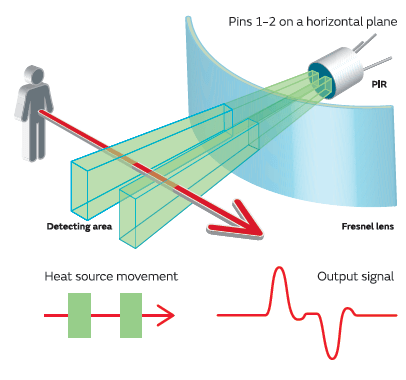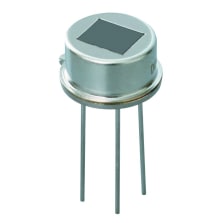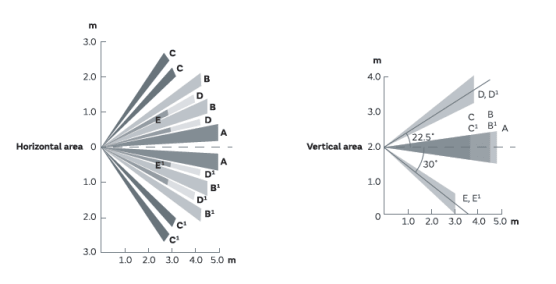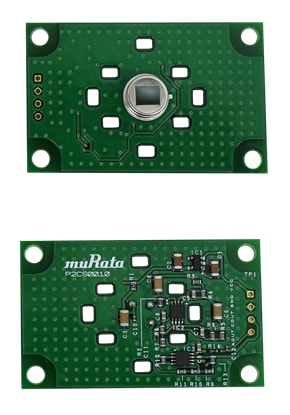Engineer’s guide to using PIR sensors for highly reliable security applications
Follow articleHow do you feel about this article? Help us to provide better content for you.
Thank you! Your feedback has been received.
There was a problem submitting your feedback, please try again later.
What do you think of this article?
Pyroelectric Infrared (PIR) sensors can be found in many commercial and domestic designs that sense motion such as those found in security and smart lighting systems. A miniature yet crucial component, the core part of the sensor is a sensing element housed in a hermetically sealed circular metal can. It is typically mounted on a small PCB together with supporting circuitry. On the outside of this a plastic Fresnel lens is mounted, usually part of the main enclosure, which has been designed to meet a specific sensing criteria such as the x / y detection angles, sensing pattern and distance.
Used in the thousands in large security alarm system installations the most critical aspect of the sensor is that of its detection performance. It needs to reliably detect motion within the detecting area, reject all false detections and have a self-checking capability that can report to the host alarm system that it has failed its own diagnostic checks. Installing sensors that do meet the requirements of a professional grade security system can not only be an inconvenience for the occupants of an office it is supposed to be protecting, but potentially result in fines from the emergency services for false calls. The consequence of this is a loss of reputation for both the alarm installer and the sensor manufacturer. There is also a regulatory consideration, but before we get into that detail let’s take a look at how the sensor functions.
Figure 1 – PIR sensor operation
The top of the sealed can have two rectangular slots in it made of a material that allows the infrared radiation to pass. Behind these are two separate balanced infrared sensor electrodes, one responsible for producing a positive output and the other a negative output. When there is nothing to detect each sensor receives the same amount of infrared radiation, this being the ambient amount radiated from the fabric, such as the walls, of the room, resulting in a zero output signal. See Figure 1. Should a source of IR energy such as a human body or animal pass by then the first sensor electrode provides an output, and as the source continues moving, the second sensor electrode produces an output. The corresponding pulse of signals results in the sensor setting its output pin high. An example of such a PIR sensor is Murata’s IRA-S210ST01 sensor (124-5981) , see Figure 2. This three-pin device is capable of operating from a +2 to +15 VDC supply and incorporates a JFET device. The JFET provides a very low noise characteristic as well as serving to impedance match the outputs to a more usable logic output level. The field of view, defined as the maximum angle that both electrodes can see the same object is 45 degrees. It has high immunity to external sources of noise such as vibration in addition to RFI.
Figure 2 – Murata PIR sensor device
Designers of security alarm systems need to comply with several internationally recognised standards in order to market their products and one of these, EN 50130, is very specific regarding the detection test criteria that the security product has to pass. Especially, the criteria of PIR detectors are provided in EN50131. The electro magnetic compatibility EMC requirements, based on EN61000, is one of the most technically demanding tests for PIR detectors. This standard stipulates the levels of interfering wireless signals and white noise that need to be rejected in order that the sensor can be used in professional-grade security systems.
EN50131-2-2 stipulates many key performance criteria such as standard walk tests given specific physical dimensions of the moving object in addition to the temperature of five different points of the body from head to feet. Other tests cover the sensor’s immunity to incorrect operation as well as a number of self-tests that the sensor should undertake to verify that it is working correctly. Included in these operations is the detection of any attempt to tamper with or intrude into the overall sensor housing. Immunity tests include pass/fail tests when exposing the detector to hot forced air flows, rejection of a visible light source and no reaction from a fluorescent light or automobile headlights.
Although not a job for the electronics engineer, the design of the lens is also a key part of designing the overall sensor unit. Using the concept of a Fresnel lens, which condenses the light and presents a larger area to the sensor, see Figure 3, they are a way of tuning the detection area and sensing pattern to suit specific applications. The clever part of the lens design is breaking up essentially one big sensing area into a number of small areas using multiple Fresnel lenses.
Figure 3 – Fresnel lens – multiple small Fresnel lenses creating the multiple detection areas
When embarking on a PIR-based sensor design engineers should look to use a sensor that provides an analogue output. This approach provides the most flexibility when designing the amplification stage and for incorporating different filters in order to process the signal. Also, the availability of an evaluation board will greatly assist in creating, prototyping and testing a design prior to final approval.
In the case of the Murata PIR sensing device mentioned above an evaluation board, the IMX-060 is available. See Figure 4.
Figure 4 - Murata IMX-060 PIR evaluation board
The board comprises an amplification circuit providing an 64dB gain, with a 6.9 Hz low pass filter and a 0.63 Hz high pass filter, for an analogue output and a comparator circuit that provides a digital output.
Security alarm systems depend on professional grade PIR sensing devices for reliable, confidence-building operation. Making sure that the PIR sensing devices you select for your design will help you meet and exceed the various regulatory requirements is key.





Comments